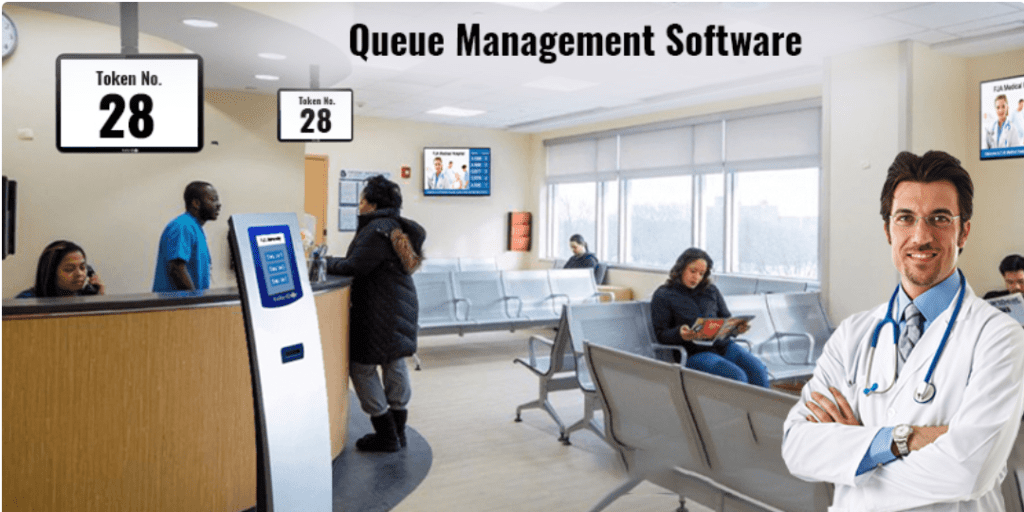Time is of great essence, especially when it comes to healthcare services. However, long waiting times at hospitals can be frustrating for patients & can even affect the quality of care they receive. Fortunately, advancements in technology such as Hospital queue management software, help tackle this issue head-on. By leveraging the power of automation & data-driven insights, this software ensures that patients receive the care they need quickly without unnecessary delays. Significantly, it reduces waiting times and enhances the overall patient experience.
In this discussion, we will delve into the unique ways in which hospital queue system optimizes queue time.
Hospital Queue System: Minimizing Waiting Time and Enhancing Overall Efficiency
Hospital Queue Management Software can significantly reduce queue time by streamlining the entire patient flow process. Here are multiple ways in which it achieves this:
Online Appointment Scheduling
The implementation of software that enables patients to book appointments online brings several benefits to patients and hospitals. Initially, it eliminates the need for patients to physically visit the hospital premises or make calls to the receptionist to schedule medical appointments. This convenience saves time & effort for patients, as they can easily access the online platform 24/7 from their computers/mobiles.
By providing patients with the ability to choose suitable time slots in advance, the hospital queue system promotes better appointment management. It reduces the number of walk-in patients, as individuals can secure their preferred appointment times in advance. Significantly, this not only improves the patient experience but also ensures a more evenly distributed patient flow throughout the day.
Virtual Check-in
Queue software with self-check-in kiosks or mobile apps has transformed the way patients check in at hospitals. Traditionally, patients had to wait in a crowded line at the reception desk to register their arrival manually. This often led to long queues, delays & increased workload for the staff members.
However, with the integration of self-check-in solutions, the check-in process becomes more efficient & streamlined. Patients can now use self-check-in kiosks or mobile apps to register their arrival by following a few easy steps. They can enter their personal information & reason for the visit directly into the system. This eliminates the need for manual data entry by receptionists, resulting in saving valuable time and improving the overall patient experience.
Real-time Queue Monitoring & Efficient Staff Allocation
The software provides real-time visibility into the queue where patients are waiting for their turn for various services, such as medical check-ups & procedures. With the help of the software, staff members can closely monitor and efficiently manage the waiting area. Significantly, this allows hospital staff to gain valuable insights into their processes and identify areas that require improvements. By addressing these bottlenecks quickly, the hospital can enhance patient satisfaction and optimize resource allocation.
Furthermore, with real-time visibility, staff can accurately assess the number of patients in the queue & estimate the time required for each patient’s service. Significantly, this information helps reduce wait time, minimizing patient frustration & improving overall operational efficiency.
Automated Notifications
Hospital queue management software can send automated notifications to patients via SMS or email to keep them informed and empowered. These notifications provide patients with updates on their estimated waiting time, promoting transparency & fostering a sense of trust. Significantly, by receiving email notifications, patients are made aware of the approximate duration of their wait, allowing them to plan their time accordingly.
Additionally, these notifications help to inform patients about any unexpected delays or changes in their scheduled appointments. Consequently, patients can adjust their schedules and avoid wasting their entire day waiting in a crowded queue line.
Integration with Other Systems
Queue management software plays a crucial role in the smooth functioning of hospitals by integrating with other essential systems. For example, electronic medical records (EMRs), laboratory systems, radiology departments, and more. Significantly, this integration facilitates seamless coordination and efficient communication between various hospital departments. Ultimately, it leads to reduced delays and enhanced patient care.
Prioritization
The software can integrate with electronic medical records and help prioritize patients based on their medical condition or urgency. However, the software utilizes various advanced algorithms & criteria to assess the urgency of each patient’s situation. It considers factors including the severity of the medical condition, the requirement for specialized treatment & the availability of healthcare providers. By evaluating this information, the software can accurately determine the priority level for each patient.
Once the prioritization is complete, the software provides healthcare professionals with a clear & organized list of patients, ranked based on urgency. This information helps hospitals allocate resources efficiently, ensuring that patients with critical conditions receive immediate attention and reducing waiting times.
Workflow Optimization
A robust hospital queue system streamlines the overall workflow by automating various administrative tasks, such as registration, data entry, documentation & more. Significantly, this helps healthcare providers save time, eliminate redundant processes, and focus more on patient care.
Concluding Remarks
In conclusion, by combining these features, hospital queue software helps healthcare facilities improve their overall efficiency, reduce patient waiting times & optimize resource utilization.

